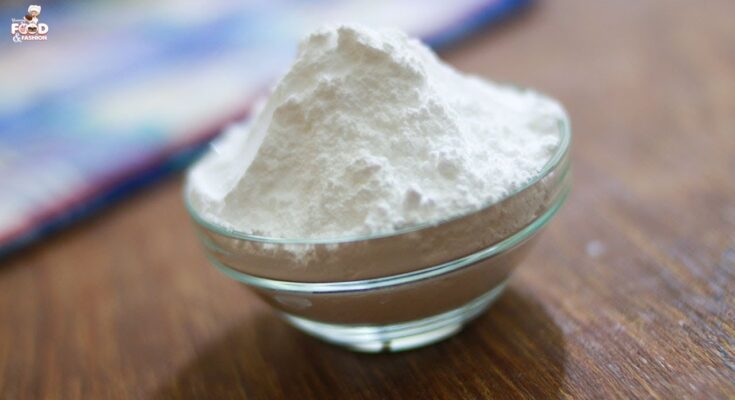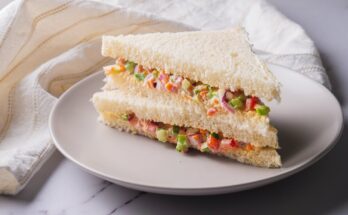Powdered Sugar Frosting Recipe: Powdered sugar frosting is the silent hero in the dessert world. Whether you’re dressing up a birthday cake, piping delicate swirls on cupcakes, or adding a sweet drizzle to cookies, this frosting delivers a smooth, sweet finish that ties your creation together. It’s simple to make, even for beginners, and the ingredients are probably already in your pantry.
Unlike complex buttercreams or meringue-based frostings, powdered sugar frosting doesn’t require any cooking or fancy techniques. Just a few common ingredients, a mixing bowl, and a good whip—and you’re good to go. It’s loved for its versatility and ease, making it the ideal go-to frosting when you’re in a pinch or baking for a crowd.
The texture can be tailored to your preference—thick for piping, thin for drizzling. Plus, it accepts flavors like vanilla, almond, or citrus beautifully. Ready to dive in? Let’s break it down step by step and make your desserts pop with flavor and charm.
Ingredients You’ll Need
To whip up this simple yet delicious frosting, you only need a handful of ingredients. Here’s the basic lineup:
- 2 cups powdered sugar (also called confectioners’ sugar)
- 2–3 tablespoons milk (you can use whole, skim, or non-dairy alternatives)
- 1/2 cup unsalted butter, softened to room temperature
- 1 teaspoon vanilla extract for classic flavor
Optional additions for variety:
- Cocoa powder for a chocolate twist
- Almond extract for a nutty note
- Lemon juice/zest for citrus flair
- Food coloring for vibrant decorating
This recipe is easily customizable. Want a thicker frosting? Use less milk. Need a glaze-like consistency? Add a little more. The butter adds richness and creaminess, but if you’re avoiding dairy, you can use plant-based butter or shortening. The vanilla rounds everything out and provides that warm, nostalgic taste we all love.
When choosing your powdered sugar, make sure it’s lump-free and fine in texture. This will make your frosting smooth and pipeable, not gritty or grainy. Most grocery stores carry standard 10x powdered sugar, which is perfect for this use.
Kitchen Tools Required
You don’t need a kitchen full of gadgets to make powdered sugar frosting, but a few tools will make the process smoother:
- Mixing bowl – Medium to large depending on your batch size
- Hand mixer or stand mixer – For faster, creamier results
- Spatula – To scrape down the sides and mix smoothly
- Sifter or fine mesh strainer – To get rid of any sugar lumps
- Measuring cups and spoons – For accuracy
- Piping bag and tips (optional) – If decorating with precision
A hand mixer is often preferred for small batches since it’s easy to clean and use. However, if you’re making a big batch for a celebration cake or large order, a stand mixer can be a time saver.
Step-by-Step Instructions
Let’s walk through the frosting process together—from sugar to sweet success.
Step 1: Sift Your Powdered Sugar
Sifting might feel like an extra step, but it makes a huge difference. Powdered sugar often clumps in storage, and you want your frosting to be ultra-smooth. Sift it into a large bowl using a fine mesh strainer or a traditional sifter.
Pro tip: If you’re in a hurry, whisking the sugar briefly can help loosen some of the clumps, but it won’t be quite as effective as sifting.
Step 2: Add Butter and Beat Until Creamy
Toss in the softened butter into your bowl of sifted sugar. Using your mixer, start blending on low speed (to avoid sugar clouds!). Once the sugar is slightly mixed, increase the speed and whip it until the butter is fully incorporated and the mixture looks crumbly but creamy.
Room temperature butter is key here. If it’s too cold, you’ll end up with chunks. Too warm, and your frosting can turn greasy.
Step 3: Add Milk and Vanilla
Slowly add 2 tablespoons of milk and the vanilla extract. Mix on medium speed until fully combined. Scrape down the sides of the bowl to make sure everything is blended evenly.
This is where your frosting begins to take shape. The mixture should start to smooth out and look fluffy. If it’s too thick, add more milk—just half a teaspoon at a time. You want to be cautious; it’s easier to thin it out than thicken it back up.
Step 4: Whip It All Together
Turn your mixer to high and whip the frosting for about 2–3 minutes. This step is where the magic happens. You’re incorporating air, which makes the frosting light, fluffy, and easy to spread or pipe.
You’ll know it’s ready when it forms soft peaks and has a smooth, cloud-like texture. If it seems too loose, don’t worry—you can thicken it back up with more powdered sugar. If it’s too thick, a splash more milk will fix it.
Step 5: Adjust Consistency
Now it’s time to adjust based on your needs:
- For piping, keep it thicker—add more sugar if necessary.
- For drizzling, make it thinner with more milk.
- For spreading, aim for a medium consistency—smooth, but not runny.
Taste it! Need more vanilla? Add it. Want to tint it? Mix in a few drops of gel food coloring. This frosting is your canvas, so make it as fun and flavorful as you like.
Tips to Nail the Perfect Frosting
Even the simplest frosting can go wrong without the right technique. Here are some tried-and-true tips to make your powdered sugar frosting perfect every single time:
- Use high-quality ingredients: This isn’t the time to skimp. Use real butter (not margarine), pure vanilla extract (not imitation), and sifted powdered sugar. These make all the difference in flavor and texture.
- Don’t skip sifting: Lumps in your sugar can lead to grainy frosting. A quick sift guarantees that silky-smooth finish.
- Start slow, end strong: Always mix on low speed first to avoid a powdered sugar explosion. Once the ingredients are blended, crank up the speed to whip it into that fluffy cloud.
- Temperature matters: Room temperature butter is your best friend. If it’s too cold, your frosting won’t mix well. Too warm, and it turns oily.
- Control the consistency: Add milk slowly—too much and your frosting will be too thin. Always add liquid in small increments and mix well before adjusting further.
- Chill when needed: If your frosting becomes too soft or you’re in a hot kitchen, chill it for 10-15 minutes in the fridge before piping or spreading.
Remember, frosting is as much about texture as it is about flavor. A smooth, spreadable consistency can transform your baked goods from homemade to bakery-worthy in no time.
Flavor Variations to Try
Bored of vanilla? No problem. Powdered sugar frosting is incredibly versatile and serves as the perfect base for different flavors. Here are some easy and delicious variations you can try:
1. Chocolate Frosting
- Add 1/4 to 1/3 cup of unsweetened cocoa powder along with the powdered sugar.
- You might need a little more milk to achieve the right consistency.
2. Lemon Frosting
- Swap vanilla extract for 1 tablespoon of fresh lemon juice and 1 teaspoon of lemon zest.
- This gives your frosting a bright, citrusy flavor that pairs beautifully with vanilla or berry cakes.
3. Almond Frosting
- Replace the vanilla extract with almond extract (use half the amount, as it’s stronger).
- Pairs great with chocolate, cherry, or white cakes.
4. Peppermint Frosting
- Add 1/2 teaspoon peppermint extract for a cool, minty bite.
- This is fantastic for holiday treats and chocolate desserts.
5. Coffee Frosting
- Dissolve 1 teaspoon of instant coffee in 1 tablespoon of milk before adding.
- Gives your frosting a rich mocha flavor, great with chocolate cupcakes.
6. Berry Frosting
- Mix in a spoonful of freeze-dried fruit powder like strawberry or raspberry.
- Offers both vibrant color and natural fruity flavor without watering down the texture.
These variations not only boost flavor but also bring an unexpected twist to your desserts. You can even mix and match extracts and add-ins to craft your own signature frosting.
Common Mistakes to Avoid
Making powdered sugar frosting is easy, but there are a few common pitfalls that can trip you up. Avoid these mistakes to keep your frosting game strong:
1. Using cold butter
- Cold butter doesn’t whip well and can cause lumps.
- Always soften it at room temperature for 30-60 minutes before using.
2. Adding too much milk too fast
- Milk thins frosting quickly.
- Add it slowly and only as much as you need to reach your desired texture.
3. Skipping the sift
- Sifting removes clumps and ensures a silky finish.
- If you skip this step, your frosting might end up lumpy and gritty.
4. Overbeating
- Overmixing can make the frosting too airy or even split it.
- Once it’s fluffy and smooth, stop mixing.
5. Not adjusting for humidity
- On humid days, your frosting can get too soft. You may need to add a little extra sugar.
- In dry climates, you might need more milk than usual.
These tips and warnings help ensure that your frosting turns out exactly how you envisioned—delicious, fluffy, and Instagram-worthy.
Best Uses for Powdered Sugar Frosting
This frosting isn’t just for cakes. Its creamy texture and sweet flavor make it a perfect topping for a wide range of desserts. Here are some of the best ways to use it:
1. Cakes
- Slather it on sheet cakes or layer it between cake rounds for a classic look and taste.
- Perfect for birthday cakes, wedding cakes, or simple everyday bakes.
2. Cupcakes
- Pipe it into swirls using a star tip for a bakery-style finish.
- Add sprinkles, mini chocolate chips, or fruit on top for extra flair.
3. Cookies
- Use a thinner consistency to drizzle over sugar cookies or shortbread.
- You can even color it and use it to decorate holiday cookies.
4. Brownies
- A thin layer of this frosting on top of a rich chocolate brownie adds an extra layer of indulgence.
5. Cinnamon Rolls
- Use it as a glaze by thinning it out with a bit more milk.
- It melts into the rolls, making each bite gooey and sweet.
This frosting really does it all. Whether you’re baking for fun, for a special occasion, or just to satisfy your sweet tooth, powdered sugar frosting is a reliable, tasty choice.
How to Store Powdered Sugar Frosting
Once you’ve whipped up a batch of perfect powdered sugar frosting, the next question is: how do you store it? Whether you’re prepping in advance or saving leftovers, proper storage is key to maintaining that smooth texture and fresh flavor.
Refrigeration
- Short-term storage (up to 5 days): Transfer the frosting to an airtight container. Press a piece of plastic wrap directly onto the surface before sealing the lid. This prevents it from forming a crust.
- Store it in the refrigerator. When ready to use, let it sit at room temperature for 20–30 minutes, then re-whip with a hand mixer to bring back its original fluffiness.
Freezing
- Long-term storage (up to 2 months): Frosting freezes surprisingly well. Scoop it into a freezer-safe container, press plastic wrap directly on the surface, and seal tightly.
- To use, thaw it in the refrigerator overnight. Let it come to room temperature, then mix it with a spatula or mixer to restore its consistency.
Tips for Best Results
- Always label your containers with the date to keep track of freshness.
- Avoid refreezing frosting once it’s been thawed. Make smaller batches if needed.
- Don’t leave frosting at room temperature for more than a few hours, especially in warmer climates.
Proper storage helps prevent waste and lets you enjoy delicious frosting anytime without the last-minute scramble.
Nutritional Information
While powdered sugar frosting is a treat, it’s good to know what you’re indulging in. Here’s a basic nutritional breakdown for one serving (about 2 tablespoons):
| Nutrient | Amount |
|---|---|
| Calories | ~140 |
| Total Fat | ~7g |
| Saturated Fat | ~4g |
| Carbohydrates | ~20g |
| Sugars | ~19g |
| Protein | ~0g |
| Cholesterol | ~20mg |
| Sodium | ~5mg |
These values may vary slightly based on the type of milk and butter used. Non-dairy versions might be lower in saturated fat but could differ in texture.
For a healthier twist, consider using lower-fat milk, reducing the sugar slightly, or swapping butter with plant-based alternatives. But remember, this frosting is meant to be a treat—so don’t stress too much over the numbers!
FAQs about Powdered Sugar Frosting Recipe
1. Can I use margarine instead of butter?
Yes, but the texture and flavor may be slightly different. Margarine tends to have more water content, which can make the frosting softer. Use it in a pinch, but butter is the gold standard for richness and structure.
2. How long does powdered sugar frosting last?
It lasts up to 5 days in the fridge or 2 months in the freezer. Just make sure it’s stored in an airtight container and brought to room temperature before using.
3. Can I make it dairy-free?
Absolutely. Use plant-based butter and any non-dairy milk like almond, soy, or oat. The result is still creamy and delicious, perfect for vegan baking.
5. Is powdered sugar the same as confectioners’ sugar?
Add more powdered sugar, 1 tablespoon at a time, until it thickens. Always mix well before adding more to avoid overcorrecting.
5. Is powdered sugar the same as confectioners’ sugar?
Yes! They’re two names for the same thing. It’s finely ground sugar with a bit of cornstarch added to prevent clumping.
Conclusion
Powdered sugar frosting is the ultimate kitchen staple—simple, sweet, and endlessly adaptable. Whether you’re a seasoned baker or a complete beginner, this recipe has you covered. From cakes and cookies to cupcakes and cinnamon rolls, its versatility makes it a go-to favorite.
With just a few ingredients and basic tools, you can whip up a batch of frosting that’s creamy, fluffy, and totally irresistible. Play around with flavors, experiment with consistencies, and make it your own. Because at the end of the day, baking should be fun—and this frosting makes it deliciously easy.
So go ahead, grab your mixer and a bowl of sugar, and let the magic begin. Your desserts will thank you!



